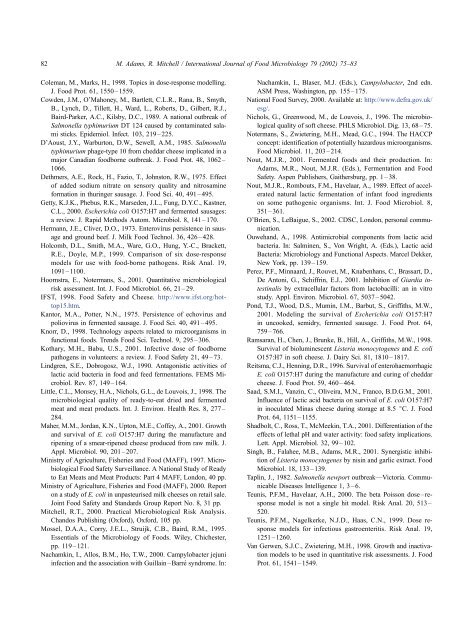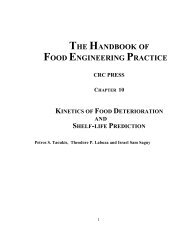Fermentation and pathogen control: a risk assessment approach
Fermentation and pathogen control: a risk assessment approach
Fermentation and pathogen control: a risk assessment approach
Create successful ePaper yourself
Turn your PDF publications into a flip-book with our unique Google optimized e-Paper software.
82M. Adams, R. Mitchell / International Journal of Food Microbiology 79 (2002) 75–83Coleman, M., Marks, H., 1998. Topics in dose-response modelling.J. Food Prot. 61, 1550–1559.Cowden, J.M., O’Mahoney, M., Bartlett, C.L.R., Rana, B., Smyth,B., Lynch, D., Tillett, H., Ward, L., Roberts, D., Gilbert, R.J.,Baird-Parker, A.C., Kilsby, D.C., 1989. A national outbreak ofSalmonella typhimurium DT 124 caused by contaminated salamisticks. Epidemiol. Infect. 103, 219–225.D’Aoust, J.Y., Warburton, D.W., Sewell, A.M., 1985. Salmonellatyphimurium phage-type 10 from cheddar cheese implicated in amajor Canadian foodborne outbreak. J. Food Prot. 48, 1062–1066.Dethmers, A.E., Rock, H., Fazio, T., Johnston, R.W., 1975. Effectof added sodium nitrate on sensory quality <strong>and</strong> nitrosamineformation in thuringer sausage. J. Food Sci. 40, 491–495.Getty, K.J.K., Phebus, R.K., Marseden, J.L., Fung, D.Y.C., Kastner,C.L., 2000. Escherichia coli O157:H7 <strong>and</strong> fermented sausages:a review. J. Rapid Methods Autom. Microbiol. 8, 141–170.Hermann, J.E., Cliver, D.O., 1973. Enterovirus persistence in sausage<strong>and</strong> ground beef. J. Milk Food Technol. 36, 426–428.Holcomb, D.L., Smith, M.A., Ware, G.O., Hung, Y.-C., Brackett,R.E., Doyle, M.P., 1999. Comparison of six dose-responsemodels for use with food-borne <strong>pathogen</strong>s. Risk Anal. 19,1091–1100.Hoornstra, E., Notermans, S., 2001. Quantitative microbiological<strong>risk</strong> <strong>assessment</strong>. Int. J. Food Microbiol. 66, 21–29.IFST, 1998. Food Safety <strong>and</strong> Cheese. http://www.ifst.org/hottop15.htm.Kantor, M.A., Potter, N.N., 1975. Persistence of echovirus <strong>and</strong>poliovirus in fermented sausage. J. Food Sci. 40, 491–495.Knorr, D., 1998. Technology aspects related to microorganisms infunctional foods. Trends Food Sci. Technol. 9, 295–306.Kothary, M.H., Babu, U.S., 2001. Infective dose of foodborne<strong>pathogen</strong>s in volunteers: a review. J. Food Safety 21, 49–73.Lindgren, S.E., Dobrogosz, W.J., 1990. Antagonistic activities oflactic acid bacteria in food <strong>and</strong> feed fermentations. FEMS Microbiol.Rev. 87, 149–164.Little, C.L., Monsey, H.A., Nichols, G.L., de Louvois, J., 1998. Themicrobiological quality of ready-to-eat dried <strong>and</strong> fermentedmeat <strong>and</strong> meat products. Int. J. Environ. Health Res. 8, 277–284.Maher, M.M., Jordan, K.N., Upton, M.E., Coffey, A., 2001. Growth<strong>and</strong> survival of E. coli O157:H7 during the manufacture <strong>and</strong>ripening of a smear-ripened cheese produced from raw milk. J.Appl. Microbiol. 90, 201–207.Ministry of Agriculture, Fisheries <strong>and</strong> Food (MAFF), 1997. MicrobiologicalFood Safety Surveillance. A National Study of Readyto Eat Meats <strong>and</strong> Meat Products: Part 4 MAFF, London, 40 pp.Ministry of Agriculture, Fisheries <strong>and</strong> Food (MAFF), 2000. Reporton a study of E. coli in unpasteurised milk cheeses on retail sale.Joint Food Safety <strong>and</strong> St<strong>and</strong>ards Group Report No. 8, 31 pp.Mitchell, R.T., 2000. Practical Microbiological Risk Analysis.Ch<strong>and</strong>os Publishing (Oxford), Oxford, 105 pp.Mossel, D.A.A., Corry, J.E.L., Struijk, C.B., Baird, R.M., 1995.Essentials of the Microbiology of Foods. Wiley, Chichester,pp. 119–121.Nachamkin, I., Allos, B.M., Ho, T.W., 2000. Campylobacter jejuniinfection <strong>and</strong> the association with Guillain–Barré syndrome. In:Nachamkin, I., Blaser, M.J. (Eds.), Campylobacter, 2nd edn.ASM Press, Washington, pp. 155–175.National Food Survey, 2000. Available at: http://www.defra.gov.uk/esg/.Nichols, G., Greenwood, M., de Louvois, J., 1996. The microbiologicalquality of soft cheese. PHLS Microbiol. Dig. 13, 68–75.Notermans, S., Zwietering, M.H., Mead, G.C., 1994. The HACCPconcept: identification of potentially hazardous microorganisms.Food Microbiol. 11, 203–214.Nout, M.J.R., 2001. Fermented foods <strong>and</strong> their production. In:Adams, M.R., Nout, M.J.R. (Eds.), <strong>Fermentation</strong> <strong>and</strong> FoodSafety. Aspen Publishers, Gaithersburg, pp. 1–38.Nout, M.J.R., Rombouts, F.M., Havelaar, A., 1989. Effect of acceleratednatural lactic fermentation of infant food ingredientson some <strong>pathogen</strong>ic organisms. Int. J. Food Microbiol. 8,351–361.O’Brien, S., LeBaigue, S., 2002. CDSC, London, personal communication.Ouweh<strong>and</strong>, A., 1998. Antimicrobial components from lactic acidbacteria. In: Salminen, S., Von Wright, A. (Eds.), Lactic acidBacteria: Microbiology <strong>and</strong> Functional Aspects. Marcel Dekker,New York, pp. 139–159.Perez, P.F., Minnaard, J., Rouvet, M., Knabenhans, C., Brassart, D.,De Antoni, G., Schiffrin, E.J., 2001. Inhibition of Giardia intestinalisby extracellular factors from lactobacilli: an in vitrostudy. Appl. Environ. Microbiol. 67, 5037–5042.Pond, T.J., Wood, D.S., Mumin, I.M., Barbut, S., Griffiths, M.W.,2001. Modeling the survival of Escherichia coli O157:H7in uncooked, semidry, fermented sausage. J. Food Prot. 64,759–766.Ramsaran, H., Chen, J., Brunke, B., Hill, A., Griffiths, M.W., 1998.Survival of bioluminescent Listeria monocytogenes <strong>and</strong> E. coliO157:H7 in soft cheese. J. Dairy Sci. 81, 1810–1817.Reitsma, C.J., Henning, D.R., 1996. Survival of enterohaemorrhagicE. coli O157:H7 during the manufacture <strong>and</strong> curing of cheddarcheese. J. Food Prot. 59, 460–464.Saad, S.M.I., Vanzin, C., Oliveira, M.N., Franco, B.D.G.M., 2001.Influence of lactic acid bacteria on survival of E. coli O157:H7in inoculated Minas cheese during storage at 8.5 jC. J. FoodProt. 64, 1151–1155.Shadbolt, C., Ross, T., McMeekin, T.A., 2001. Differentiation of theeffects of lethal pH <strong>and</strong> water activity: food safety implications.Lett. Appl. Microbiol. 32, 99–102.Singh, B., Falahee, M.B., Adams, M.R., 2001. Synergistic inhibitionof Listeria monocytogenes by nisin <strong>and</strong> garlic extract. FoodMicrobiol. 18, 133–139.Taplin, J., 1982. Salmonella newport outbreak—Victoria. CommunicableDiseases Intelligence 1, 3 – 6.Teunis, P.F.M., Havelaar, A.H., 2000. The beta Poisson dose–responsemodel is not a single hit model. Risk Anal. 20, 513–520.Teunis, P.F.M., Nagelkerke, N.J.D., Haas, C.N., 1999. Dose responsemodels for infectious gastroenteritis. Risk Anal. 19,1251–1260.Van Gerwen, S.J.C., Zwietering, M.H., 1998. Growth <strong>and</strong> inactivationmodels to be used in quantitative <strong>risk</strong> <strong>assessment</strong>s. J. FoodProt. 61, 1541–1549.














